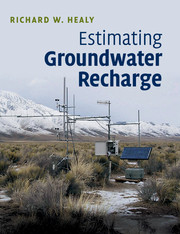Book contents
- Frontmatter
- Contents
- Preface
- Acknowledgments
- 1 Groundwater recharge
- 2 Water-budget methods
- 3 Modeling methods
- 4 Methods based on surface-water data
- 5 Physical methods: unsaturated zone
- 6 Physical methods: saturated zone
- 7 Chemical tracer methods
- 8 Heat tracer methods
- 9 Linking estimation methods to conceptual models of groundwater recharge
- References
- Index
3 - Modeling methods
Published online by Cambridge University Press: 05 April 2013
- Frontmatter
- Contents
- Preface
- Acknowledgments
- 1 Groundwater recharge
- 2 Water-budget methods
- 3 Modeling methods
- 4 Methods based on surface-water data
- 5 Physical methods: unsaturated zone
- 6 Physical methods: saturated zone
- 7 Chemical tracer methods
- 8 Heat tracer methods
- 9 Linking estimation methods to conceptual models of groundwater recharge
- References
- Index
Summary
Introduction
Simulation models are widely used in all types of hydrologic studies, and many of these models can be used to estimate recharge. Models can provide important insight into the functioning of hydrologic systems by identifying factors that influence recharge. The predictive capability of models can be used to evaluate how changes in climate, water use, land use, and other factors may affect recharge rates. Most hydrological simulation models, including watershed models and groundwater-flow models, are based on some form of water-budget equation, so the material in this chapter is closely linked to that in Chapter 2. Empirical models that are not based on a water-budget equation have also been used for estimating recharge; these models generally take the form of simple estimation equations that define annual recharge as a function of precipitation and possibly other climatic data or watershed characteristics.
Model complexity varies greatly. Some models are simple accounting models; others attempt to accurately represent the physics of water movement through each compartment of the hydrologic system. Some models provide estimates of recharge explicitly; for example, a model based on the Richards equation can simulate water movement from the soil surface through the unsaturated zone to the water table. Recharge estimates can be obtained indirectly from other models. For example, recharge is a parameter in groundwater-flow models that solve for hydraulic head (i.e. groundwater level). Recharge estimates can be obtained through a model calibration process in which recharge and other model parameter values are adjusted so that simulated water levels agree with measured water levels. The simulation that provides the closest agreement is called the best fit, and the recharge value used in that simulation is the model-generated estimate of recharge.
- Type
- Chapter
- Information
- Estimating Groundwater Recharge , pp. 43 - 73Publisher: Cambridge University PressPrint publication year: 2010



